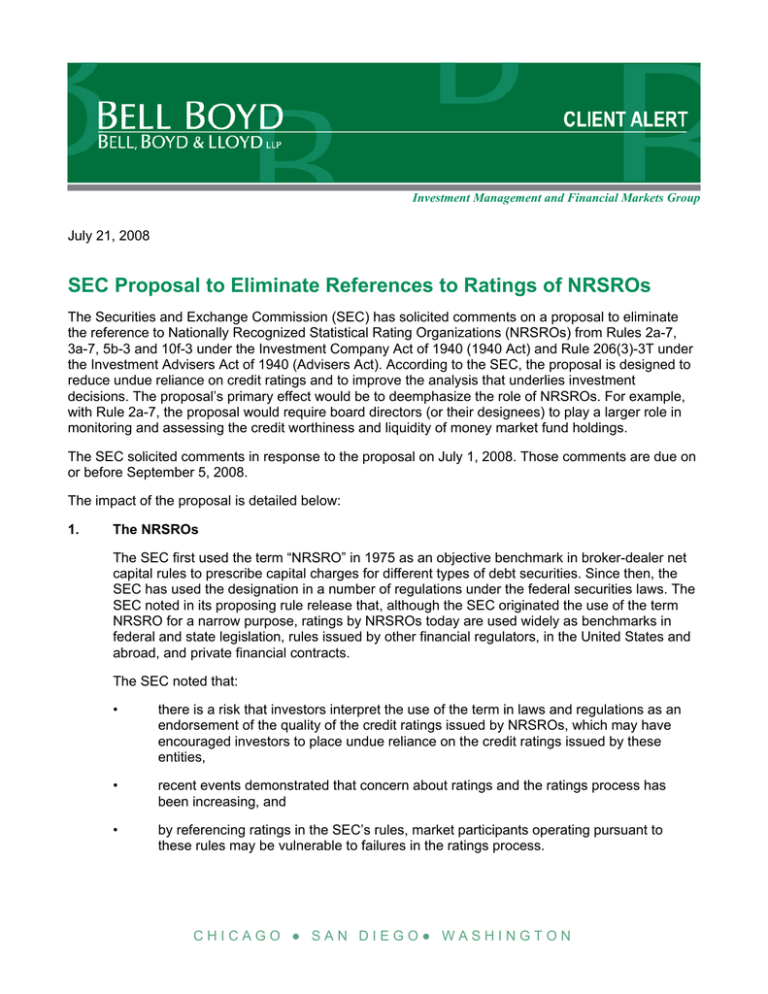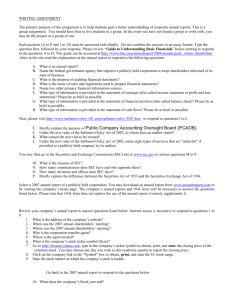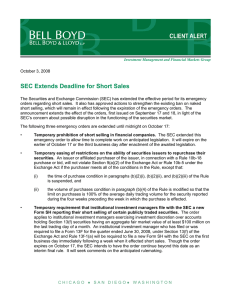
Investment Management and Financial Markets Group
July 21, 2008
SEC Proposal to Eliminate References to Ratings of NRSROs
The Securities and Exchange Commission (SEC) has solicited comments on a proposal to eliminate
the reference to Nationally Recognized Statistical Rating Organizations (NRSROs) from Rules 2a-7,
3a-7, 5b-3 and 10f-3 under the Investment Company Act of 1940 (1940 Act) and Rule 206(3)-3T under
the Investment Advisers Act of 1940 (Advisers Act). According to the SEC, the proposal is designed to
reduce undue reliance on credit ratings and to improve the analysis that underlies investment
decisions. The proposal’s primary effect would be to deemphasize the role of NRSROs. For example,
with Rule 2a-7, the proposal would require board directors (or their designees) to play a larger role in
monitoring and assessing the credit worthiness and liquidity of money market fund holdings.
The SEC solicited comments in response to the proposal on July 1, 2008. Those comments are due on
or before September 5, 2008.
The impact of the proposal is detailed below:
1.
The NRSROs
The SEC first used the term “NRSRO” in 1975 as an objective benchmark in broker-dealer net
capital rules to prescribe capital charges for different types of debt securities. Since then, the
SEC has used the designation in a number of regulations under the federal securities laws. The
SEC noted in its proposing rule release that, although the SEC originated the use of the term
NRSRO for a narrow purpose, ratings by NRSROs today are used widely as benchmarks in
federal and state legislation, rules issued by other financial regulators, in the United States and
abroad, and private financial contracts.
The SEC noted that:
•
there is a risk that investors interpret the use of the term in laws and regulations as an
endorsement of the quality of the credit ratings issued by NRSROs, which may have
encouraged investors to place undue reliance on the credit ratings issued by these
entities,
•
recent events demonstrated that concern about ratings and the ratings process has
been increasing, and
•
by referencing ratings in the SEC’s rules, market participants operating pursuant to
these rules may be vulnerable to failures in the ratings process.
CHICAGO ● SAN DIEGO● WASHINGTON
2.
Rule 2a-7
The SEC proposes to eliminate references to ratings by amending Rule 2a-7 in four principal
ways:
(i)
Minimal Credit Risk Determination - Under the proposed amendments, the SEC would
rely on money market fund boards of directors (or their delegates) to determine whether
each portfolio instrument presents minimal credit risks, and whether the security is a
“First Tier Security” or a “Second Tier Security.”1
(ii)
Portfolio Liquidity - Under the proposed amendments, a money market fund must hold
securities that are sufficiently liquid to meet reasonably foreseeable redemptions in light
of the fund’s obligations under Section 22(e) of the 1940 Act and any commitments the
fund has made to its shareholders. In addition, the proposed amendments would codify
the current standard regarding portfolio liquidity, and expressly limit a money market
fund’s investment in illiquid securities to not more than 10 percent of its total assets. The
proposed amendments would define a Liquid Security as a security that can be sold or
disposed of in the ordinary course of business within seven days at approximately the
value ascribed to it by the money market fund. In the event that changes in the money
market fund’s portfolio or other external events cause the fund’s investments in illiquid
instruments to exceed 10 percent of the fund’s assets, the money market fund would
have to take steps to bring the aggregate amount of illiquid securities back within the
proposed limitations as soon as reasonably practicable. However, consistent with the
current rule, this requirement generally would not force the money market fund to
liquidate any portfolio security where the fund would suffer a loss on the sale of that
instrument.
(iii)
Monitoring Minimal Credit Risks - The SEC proposed that in the event the money
market fund’s investment adviser becomes aware of any information about a portfolio
security or an issuer of a portfolio security that suggests that the security may not
continue to present minimal credit risks, the money market fund’s board of directors
would have to reassess promptly whether the portfolio security continues to present
minimal credit risks.2 The SEC clarified that it does not expect investment advisers to
subscribe to every rating service publication to comply with this proposal. However, the
SEC would expect an investment adviser to exercise reasonable diligence in keeping
abreast of new information about a portfolio security that is reported in the national
financial press or in publications to which the investment adviser subscribes.
(iv)
Commission Notice of Rule 17a-9 Transactions - The proposed amendments would
require that money market funds provide the SEC with prompt notice when an affiliate of
the money market fund (or its promoter or principal underwriter) purchases from the fund
a security that no longer is an Eligible Security, pursuant to Rule 17a-9 under the 1940
Act.
1
A security would be a First Tier Security if the fund’s board had determined that the issuer has the “highest capacity to
meet its short-term financial obligations.” A security would be a Second Tier Security if it is an Eligible Security but is not
a First Tier Security.
2
This proposed requirement would replace the provisions in the current rule that generally require a money market fund
board to promptly reassess whether a security that has been downgraded by an NRSRO continues to present minimal
credit risks, and take such action as the board determines is in the best interests of the fund and its shareholders.
2
3.
Rule 3a-7
The SEC proposes to eliminate from Rule 3a-7 the exclusion for structured financings offered to
the general public. In addition, the SEC proposes to amend the part of the rule that addresses
substitution of eligible assets to remove the reference to ratings downgrades.
The Rule currently permits an issuer to acquire additional eligible assets or dispose of assets
only if, among other conditions, the acquisition or disposition of the assets does not result in a
downgrading in the rating of the issuer’s outstanding fixed-income securities. The SEC
proposed to require instead that the issuer adopt procedures to ensure that the acquisition or
disposition does not adversely affect the full and timely payment of the outstanding fixed income
securities. Further, the SEC proposes to amend the portion of the rule that deals with the
safekeeping of assets and require that the cash flows be deposited in a segregated account
consistent with the full and timely payment of the outstanding fixed income securities.
4.
Rule 5b-3
Collateral Securities - The SEC proposes to eliminate the requirement that collateral other
than cash or government securities be rated by an NRSRO. As an alternative, the SEC
proposed that, if the collateral is not cash or government securities, the fund’s board of directors
(or its delegate) must determine that the collateral securities present minimum credit risks and
are highly liquid.3 Although the rule no longer would require the collateral to be rated by an
NRSRO, the SEC anticipates that evaluating credit risk and liquidity of the collateral could
incorporate ratings, reports, analyses, and other assessments issued by NRSROs and other
persons.
Refunded Securities - NRSRO ratings also are used in a provision of Rule 5b-3 that permits a
fund to deem the acquisition of a “refunded security” as the acquisition of the escrowed
government securities for purposes of section 5(b)(1)’s diversification requirements. Under this
provision, a debt security must satisfy certain conditions to be considered a refunded security
under the rule. One of those conditions is that an independent certified public accountant must
have certified to the escrow agent that the escrowed securities will satisfy all scheduled
payments of principal, interest and applicable premiums on the refunded securities. This
condition is not required, however, if the refunded security has received a debt rating in the
highest rating category from an NRSRO. The SEC proposes to eliminate the exception to the
certification requirement for securities that have received the highest rating from an NRSRO.
5.
Rule 10f-3
Rule 10f-3 defines municipal securities that may be purchased during an underwriting in
reliance on the rule to include securities that have an investment grade rating from at least one
NRSRO or, if the issuer or the entity supplying the revenues or other payments from which the
issue is to be paid has been in continuous operation for less than three years (i.e., a less
seasoned security), one of the three highest ratings from an NRSRO. The SEC proposes to
eliminate the references to ratings in Rule 10f-3, and to amend the rule’s definition of “eligible
municipal security” to mean securities that are sufficiently liquid that they can be sold at or near
their carrying value within a reasonably short period of time. In addition, the securities would
3
Specifically, the proposal would require collateral other than cash or government securities to consist of securities that
the fund’s board of directors (or its delegate) determines at the time the repurchase agreement is entered into (i) are
sufficiently liquid that they can be sold at or near their carrying value within a reasonably short period of time, (ii) are
subject to no greater than minimal credit risk, and (iii) are issued by a person that has the highest capacity to meet its
financial obligations.
3
have to be either: (i) subject to no greater than moderate credit risk; or (ii) if they are less
seasoned securities, subject to a minimal or low amount of credit risk.
In light of the fact that Rule 10f-3 requires a fund’s directors, including a majority of disinterested
directors, to approve procedures regarding purchases made in reliance of the Rule and to
determine each quarter that all purchases were made in compliance with the procedures, the
SEC is not proposing to add a requirement that the board of directors makes the determination
regarding credit risk and liquidity. Fund boards of directors would still be able to incorporate
quality determinations prepared by outside sources, including ratings, reports, analyses and
other assessments issued by NRSROs and other persons, in their approval of procedures and
in their review of transactions under the rule.
6.
Rule 206(3)-3T
Rule 206(3)-3(T) defines an “investment grade debt security” as a non-convertible debt security
that, at the time of sale, is rated in one of the four highest rating categories of at least two
NRSROs. The SEC proposes to amend the rule to eliminate an adviser’s ability to rely
exclusively on NRSRO ratings to determine whether a security is investment grade for purposes
of the rule. Instead, the adviser would have to make its own assessment taking into account
specified criteria, including that the security: (i) has no greater than moderate credit risk; and (ii)
is sufficiently liquid that it can be sold at or near its carrying value within a reasonably short
period of time. An adviser seeking to rely on Rule 206(3)-3T would have to adopt and implement
policies and procedures that address the adviser’s methodology for determining whether a
security is investment grade quality.
For further information, please contact Cameron Avery 312-807-4302, Kevin Bettsteller 312-807-4442,
Paul Dykstra 312-781-6029, David Glatz 312-807-4295, Alan Goldberg 312-807-4227, Elizabeth Hudson 312-807-4376,
Anna Paglia 312-781-7163, Andrew Pfau 312-807-4386, Paulita Pike 312-781-6027, Eric Purple 202-955-7081,
Bruce Rosenblum 202-955-7087, Donald Weiss 312-807-4303, Gwendolyn Williamson 202-955-7059, or
Stacy Winick 202-955-7040 of Bell, Boyd & Lloyd’s Investment Management and Financial Markets Group or visit our
Web site at www.bellboyd.com.
This publication has been prepared by the Investment Management and Financial Markets Group of Bell, Boyd & Lloyd LLP
for clients and friends of the firm and is for information only. It is not a substitute for legal advice or individual analysis of a
particular legal matter. Readers should not act without seeking professional legal counsel. Transmission and receipt of this
publication does not create an attorney-client relationship.
© 2008 Bell, Boyd & Lloyd LLP All Rights Reserved
www.bellboyd.com
70 West Madison Street
Chicago, Illinois 60602
t. 312-372-1121
f. 312-827-8000
3580 Carmel Mountain Road
San Diego, California 92130
t. 858-509-7400
f. 858-509-7466
1615 L Street, N.W.
Washington, DC 20036
t. 202-466-6300
f. 202-463-0678



